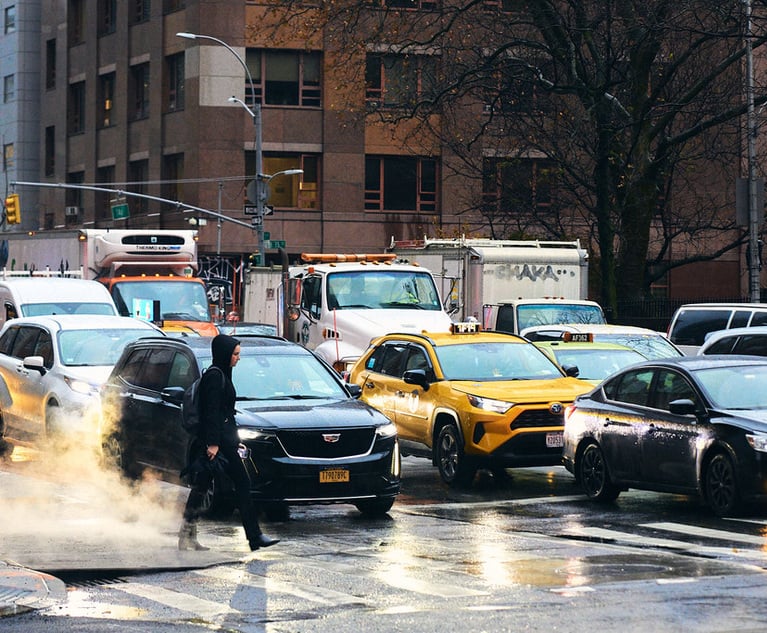Tension Between Site Remediation and Expeditious Estate Administration
When considering environmental liabilities in the context of an estate administration, property owners can take proactive steps to abate the risk, or at least make it more manageable for their heirs.
March 25, 2020 at 01:30 PM
9 minute read

When considering environmental liabilities in the context of an estate administration, property owners can take proactive steps to abate the risk, or at least make it more manageable for their heirs.
|Claims Against Estates
Environmental liabilities generally do not lend themselves to the typical resolution procedure applicable to non-environmental liabilities in estate administrations. Generally, a creditor of a decedent has nine months from the date of the decedent's death to present a claim in writing to the executor or administrator of the decedent's estate (collectively "Personal Representative"; N.J.S.A. 3B:22-4). If a creditor fails to present a claim within the nine-month period, the Personal Representative is not personally liable to the creditor with respect to any assets that the Personal Representative may have delivered or paid in satisfaction of any lawful claims, devises, or distributive shares. Id. After the expiration of the nine-month period and distribution of estate assets, creditors can still pursue their claims against estate beneficiaries under their Refunding Bonds (N.J.S.A. 3B:22-16).
However, Personal Representatives of estates whose decedent held potentially contaminated real property, in his or her individual name or in a general partnership, face unique and difficult challenges in attempting to satisfy obligations under environmental law within the statutory framework discussed above. There are two distinct reasons for this difficulty: (a) environmental liabilities of estates often have not been quantified, an often-lengthy process; and (b) long-tail obligations may attach when an environmental remediation leaves contamination on-site and engineering and institutional controls are utilized.
The enactment of the Site Remediation Reform Act (SRRA) in 2009 should have largely eliminated the first problem, since all properties with historical (pre-SRRA) contamination should already have been reported and investigated. Unlike the Industrial Site Recovery Act (ISRA) (which mandated remediation of only a subset of properties—generally properties with operating manufacturing, and certain warehousing and service businesses—and only upon their sale or closure), the SRRA required reporting of all properties with known contamination and set forth a strict schedule for completion of investigation (five years from the 2012 effective date, i.e., 2017) and remediation (10 years, i.e., 2022). Thus, by now, all contaminated properties existing in 2009 should have been identified, the investigation completed, and the remediation well underway.
The reality, however, is different. Without a pressing transaction and the attendant infusion of funds, many owners of historically contaminated properties, especially those with no current productive use, simply have not complied with the SRRA's mandates. Unlike ISRA matters, without a purchaser pushing for compliance and without an infusion of new funds, many owners felt neither the pressure to report nor the ability to fund an investigation and remediation; thus, their property remains unaddressed.
However, upon the death of the property owner, the Personal Representative of the property owner's estate now has the compliance obligation and should not risk sanctions for non-compliance. Naturally, the Personal Representative will face challenges in selling real property that needs to be liquidated for the payment of debts, expenses, and taxes, and for ultimate distribution to the beneficiaries. Where property is specifically bequeathed, the beneficiary is faced with the decision of whether to disclaim the property (a decision that must be made, pursuant to Internal Revenue Code Section 2518, within nine months of death to avoid U.S. Gift Tax consequences), or perhaps assert claims against the remainder of the estate for additional funds to investigate and remediate the contaminated property.
|Timing Challenges
Personal Representatives face the timing challenges posed by the fact that the Preliminary Assessment, Site Investigation and Remedial Investigation ("PA," "SI" and "RI,") process can take several years. With the SRRA's creation of the Licensed Site Remediation Professional (LSRP), the delay of seeking NJDEP approval at each step of the remedial process has been reduced. Nevertheless, inherent delays are associated with the process of preparing the PA, SI and RI. In addition, the finality of the "end" of the remedial process, the issuance of a Remedial Action Outcome (RAO), is subject to a three-year period during which NJDEP can audit and overturn the RAO.
The other timing issue is that the obligations of the Responsible Party (RP) may never end. If contaminated soils are left in place under an impermeable cap (typically pavement, building slab, engineered greenscape, etc.), subject to a deed notice (often the only rational and cost-effective remedy), it is accompanied by a Soils Remedial Action Permit (Soils RAP). The RP is perpetually the permittee, although the then-current owner is a co-permittee. The Soils RAP requires inspection and maintenance of the cap, annual inspection, biennial report, annual fee, and perpetual establishment and maintenance of "hard" Financial Assurance (FA) in the form of a letter of credit, line of credit, or fully-funded trust in the amount of the net present value of performing the permit conditions.
Matters involving groundwater contamination may require groundwater treatment, but even then, the very stringent State Groundwater Quality Standards (GWQS) are often not achieved. In those fairly typical situations, the only remaining remedy is Natural Monitored Attenuation. That means natural dilution and degradation processes are modeled, and a projection of the size and duration of the contaminated plume is calculated. The RP is obligated to periodically (typically annually, sometimes for 20 years or more) sample the groundwater plume for the calculated duration to ascertain that the GWQS have been achieved. If they have not, then the RP may have to extend the period of monitoring, or in some circumstances, implement additional remedial measures. These obligations are incorporated into a Groundwater RAP. As with a Soils RAP, the original RP is perpetually a permittee, with the current property owner a co-permittee. Unlike a Soils RAP, no FA is required.
|Dealing with Environmental Liabilities in Estate Administration
Statutory liability for environmental liabilities is generally fixed, but the amount and timing of the payment obligation are uncertain, particularly where the investigative and remedial process is ongoing. In that circumstance, the Personal Representative would be ill-advised to distribute estate assets, even upon receipt of refunding bonds from all beneficiaries, without establishing an adequate reserve for environmental liabilities (See, N.J.S.A. 3B:22-11). But in the context of environmental liabilities, what amount will be adequate?
Naturally the most conservative approach would be for the Personal Representative to keep the estate open and retain all assets available to satisfy the estate's remedial obligations until completion. However, as indicated above, resolution may not come for many years after the decedent's death, leading the Personal Representatives to seek alternatives to expedite distribution of estate assets to beneficiaries to the extent possible without exposing themselves to personal liability.
One approach could be for the Personal Representative to seek an LSRP's guidance to calculate an adequate reserve for environmental obligations and incorporate that reserve into an application for approval of a formal judicial accounting and discharge, putting the DEP on notice as an interested party. While liability may still exist for the beneficiaries under their refunding bonds, a discharge orchestrated in this manner should serve to exonerate the Personal Representative from personal liability for making distributions in excess of the reserve (See, N.J.S.A. 3B:17-8).
The Personal Representative may also want to seek advice and direction from the court in certain situations before expending estate assets on environmental investigation, remediation and clean-up costs. For example, residuary beneficiaries and specific devisees of contaminated real property are likely to differ on the extent to which estate funds should be expended on environmental remediation costs, particularly where the liquid assets of the estate are not significant in relation to the potential exposure. An action for advice and direction gives all parties the opportunity to be heard and can protect the Personal Representative from potential breach of fiduciary duty claims.
In sum, when considering environmental liabilities in the context of an estate administration, the adage "the best defense is a good offense" is apt. A review of the case law and statutes regarding environmental liability reveals that transparency is key. Property owners who know their property may be susceptible to environmental liability claims should be upfront with their executors, trustees, beneficiaries, and heirs to make them aware of potential issues facing properties that these people will come to own and/or manage. Transparency will also empower fiduciaries and/or beneficiaries to preserve the defenses available to them under state and federal environmental liability laws. For example, under both the Comprehensive Environmental Response Compensation and Liability Act of 1980 (CERCLA) (federal law) and the New Jersey Spill Compensation and Control Act (NJ Spill Act) (state law), the "innocent purchaser" defense is available to subsequent titleholders of contaminated property who are able to prove that they made reasonable and appropriate inquiry into the condition of the property, the past owners of the property, and previous uses of the property; and to those who have not contributed to the contamination. Without knowledge of a potential contamination problem, or the threat thereof, subsequent titleholders are not likely to engage in a high level of due diligence prior to taking title to a property.
In addition to preserving defenses available to a subsequent titleholder, being transparent in acknowledging and investigating the source of the problem may also highlight any right to contribution from previous owners or dischargers that the property owner may have. Such defenses may be preserved and carried forward by the Personal Representative or heirs upon the property owner's death.
Finally, although there is no way to totally remove the specter of environmental liability issues cast upon fiduciaries, beneficiaries, and heirs, a property owner facing these challenges can take proactive steps to abate the risk or make it more manageable for those they leave behind.
Edward A. Hogan is co-chair of the Environmental Law Group at Norris McLoughlin in Bridgewater. James J. Costello Jr. is co-chair of the firm's Trust, Estate, and Individual Tax Group. The authors are grateful for the assistance of their colleagues, Nicholas J. Dimakos and Shauna M. Deans, who are associates at the firm.
This content has been archived. It is available through our partners, LexisNexis® and Bloomberg Law.
To view this content, please continue to their sites.
Not a Lexis Subscriber?
Subscribe Now
Not a Bloomberg Law Subscriber?
Subscribe Now
NOT FOR REPRINT
© 2025 ALM Global, LLC, All Rights Reserved. Request academic re-use from www.copyright.com. All other uses, submit a request to [email protected]. For more information visit Asset & Logo Licensing.
You Might Like
View All
Send Us Your New Partners for the NJ Law Journal's New Partners Yearbook
1 minute read
New Methods for Clients and Families to Have Their Estate and Legacy Planning Complete
5 minute read
Tensions Run High at Final Hearing Before Manhattan Congestion Pricing Takes Effect
4 minute readTrending Stories
- 1Courts, Lawyers Press On With Business as SoCal Wildfires Rage
- 2Florida, a Political Epicenter, Is the Site of Brownstein Hyatt's 13th Office
- 3Law Firms Close Southern California Offices Amid Devastating Wildfires
- 4Lawsuit alleges racial and gender discrimination led to an Air Force contractor's death at California airfield
- 5Holland & Knight Picks Up 8 Private Wealth Lawyers in Los Angeles
Who Got The Work
Michael G. Bongiorno, Andrew Scott Dulberg and Elizabeth E. Driscoll from Wilmer Cutler Pickering Hale and Dorr have stepped in to represent Symbotic Inc., an A.I.-enabled technology platform that focuses on increasing supply chain efficiency, and other defendants in a pending shareholder derivative lawsuit. The case, filed Oct. 2 in Massachusetts District Court by the Brown Law Firm on behalf of Stephen Austen, accuses certain officers and directors of misleading investors in regard to Symbotic's potential for margin growth by failing to disclose that the company was not equipped to timely deploy its systems or manage expenses through project delays. The case, assigned to U.S. District Judge Nathaniel M. Gorton, is 1:24-cv-12522, Austen v. Cohen et al.
Who Got The Work
Edmund Polubinski and Marie Killmond of Davis Polk & Wardwell have entered appearances for data platform software development company MongoDB and other defendants in a pending shareholder derivative lawsuit. The action, filed Oct. 7 in New York Southern District Court by the Brown Law Firm, accuses the company's directors and/or officers of falsely expressing confidence in the company’s restructuring of its sales incentive plan and downplaying the severity of decreases in its upfront commitments. The case is 1:24-cv-07594, Roy v. Ittycheria et al.
Who Got The Work
Amy O. Bruchs and Kurt F. Ellison of Michael Best & Friedrich have entered appearances for Epic Systems Corp. in a pending employment discrimination lawsuit. The suit was filed Sept. 7 in Wisconsin Western District Court by Levine Eisberner LLC and Siri & Glimstad on behalf of a project manager who claims that he was wrongfully terminated after applying for a religious exemption to the defendant's COVID-19 vaccine mandate. The case, assigned to U.S. Magistrate Judge Anita Marie Boor, is 3:24-cv-00630, Secker, Nathan v. Epic Systems Corporation.
Who Got The Work
David X. Sullivan, Thomas J. Finn and Gregory A. Hall from McCarter & English have entered appearances for Sunrun Installation Services in a pending civil rights lawsuit. The complaint was filed Sept. 4 in Connecticut District Court by attorney Robert M. Berke on behalf of former employee George Edward Steins, who was arrested and charged with employing an unregistered home improvement salesperson. The complaint alleges that had Sunrun informed the Connecticut Department of Consumer Protection that the plaintiff's employment had ended in 2017 and that he no longer held Sunrun's home improvement contractor license, he would not have been hit with charges, which were dismissed in May 2024. The case, assigned to U.S. District Judge Jeffrey A. Meyer, is 3:24-cv-01423, Steins v. Sunrun, Inc. et al.
Who Got The Work
Greenberg Traurig shareholder Joshua L. Raskin has entered an appearance for boohoo.com UK Ltd. in a pending patent infringement lawsuit. The suit, filed Sept. 3 in Texas Eastern District Court by Rozier Hardt McDonough on behalf of Alto Dynamics, asserts five patents related to an online shopping platform. The case, assigned to U.S. District Judge Rodney Gilstrap, is 2:24-cv-00719, Alto Dynamics, LLC v. boohoo.com UK Limited.
Featured Firms
Law Offices of Gary Martin Hays & Associates, P.C.
(470) 294-1674
Law Offices of Mark E. Salomone
(857) 444-6468
Smith & Hassler
(713) 739-1250







